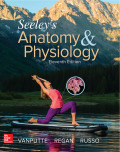
Introduction:
The vertebral column is also referred to as the spinal column. It is a part of the body that is responsible for the protection of the spinal cord. It supports the head and the skull. The vertebrae are the parts of the vertebral column.
Answer to Problem 1RAC
The correct answer is option (d) level of the foramen magnum to the second lumbar vertebra.
Explanation of Solution
Explanation/justification for the correct answer:
Option (d) level of the foramen magnum to the second lumbar vertebra. The spinal cord is a very important structure that extends from the brain at the particular level of foramen magnum down to the second lumbar vertebra. It is relatively shorter than the vertebral column due to the lack of rapid growth during the developmental stages. So, the correct answer is option (c).
Explanation for incorrect answer:
Option (a) medulla oblongata to the coccyx. The spinal cord does not extend from medulla oblongata to the coccyx. So, this is an incorrect option.
Option (b) level of the third cervical vertebra to the coccyx. The extension of the spinal cord occurs from the level of the foramen magnum to the second lumbar vertebra. So, this is an incorrect answer.
Option (c) level of the axis to the lowest lumbar vertebra. The spinal cord does not extend from the level of the axis to the lowest lumbar vertebra. So, this is an incorrect answer.
Option (e) axis to the sacral hiatus. The extension of the spinal cord does not take place from the axis to the sacral hiatus. So, this is an incorrect answer.
Thus, an extension of the spinal cord occurs from the level of the foramen magnum to the second lumbar vertebra. Hence, the correct answer is option (d) level of the foramen magnum to the second lumbar vertebra.
Want to see more full solutions like this?
Chapter 12 Solutions
EBK SEELEY'S ANATOMY & PHYSIOLOGY
- Amino Acid Coclow TABle 3' Gly Phe Leu (G) (F) (L) 3- Val (V) Arg (R) Ser (S) Ala (A) Lys (K) CAG G Glu Asp (E) (D) Ser (S) CCCAGUCAGUCAGUCAG 0204 C U A G C Asn (N) G 4 A AGU C GU (5) AC C UGA A G5 C CUGACUGACUGACUGAC Thr (T) Met (M) lle £€ (1) U 4 G Tyr Σε (Y) U Cys (C) C A G Trp (W) 3' U C A Leu בוט His Pro (P) ££ (H) Gin (Q) Arg 흐름 (R) (L) Start Stop 8. Transcription and Translation Practice: (Video 10-1 and 10-2) A. Below is the sense strand of a DNA gene. Using the sense strand, create the antisense DNA strand and label the 5' and 3' ends. B. Use the antisense strand that you create in part A as a template to create the mRNA transcript of the gene and label the 5' and 3' ends. C. Translate the mRNA you produced in part B into the polypeptide sequence making sure to follow all the rules of translation. 5'-AGCATGACTAATAGTTGTTGAGCTGTC-3' (sense strand) 4arrow_forwardWhat is the structure and function of Eukaryotic cells, including their organelles? How are Eukaryotic cells different than Prokaryotic cells, in terms of evolution which form of the cell might have came first? How do Eukaryotic cells become malignant (cancerous)?arrow_forwardWhat are the roles of DNA and proteins inside of the cell? What are the building blocks or molecular components of the DNA and proteins? How are proteins produced within the cell? What connection is there between DNA, proteins, and the cell cycle? What is the relationship between DNA, proteins, and Cancer?arrow_forward
- please fill in the empty sports, thank you!arrow_forwardIn one paragraph show how atoms and they're structure are related to the structure of dna and proteins. Talk about what atoms are. what they're made of, why chemical bonding is important to DNA?arrow_forwardWhat are the structure and properties of atoms and chemical bonds (especially how they relate to DNA and proteins).arrow_forward
- The Sentinel Cell: Nature’s Answer to Cancer?arrow_forwardMolecular Biology Question You are working to characterize a novel protein in mice. Analysis shows that high levels of the primary transcript that codes for this protein are found in tissue from the brain, muscle, liver, and pancreas. However, an antibody that recognizes the C-terminal portion of the protein indicates that the protein is present in brain, muscle, and liver, but not in the pancreas. What is the most likely explanation for this result?arrow_forwardMolecular Biology Explain/discuss how “slow stop” and “quick/fast stop” mutants wereused to identify different protein involved in DNA replication in E. coli.arrow_forward
 Fundamentals of Sectional Anatomy: An Imaging App...BiologyISBN:9781133960867Author:Denise L. LazoPublisher:Cengage Learning
Fundamentals of Sectional Anatomy: An Imaging App...BiologyISBN:9781133960867Author:Denise L. LazoPublisher:Cengage Learning- Surgical Tech For Surgical Tech Pos CareHealth & NutritionISBN:9781337648868Author:AssociationPublisher:Cengage
 Concepts of BiologyBiologyISBN:9781938168116Author:Samantha Fowler, Rebecca Roush, James WisePublisher:OpenStax College
Concepts of BiologyBiologyISBN:9781938168116Author:Samantha Fowler, Rebecca Roush, James WisePublisher:OpenStax College Medical Terminology for Health Professions, Spira...Health & NutritionISBN:9781305634350Author:Ann Ehrlich, Carol L. Schroeder, Laura Ehrlich, Katrina A. SchroederPublisher:Cengage Learning
Medical Terminology for Health Professions, Spira...Health & NutritionISBN:9781305634350Author:Ann Ehrlich, Carol L. Schroeder, Laura Ehrlich, Katrina A. SchroederPublisher:Cengage Learning





